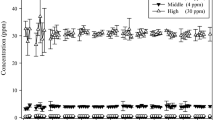Summary
The metabolic pathway of inhaled NO in rats was investigated with 15NO. After 15NO exposure, the content of the 15N (atom % excess) in blood, red cells, serum, each organ tissue (perfused with saline solution) and urine were estimated. The contents of 15N in the samples of blood, serum, red cells, and urine were relatively high and those of lung, trachea, liver, kidney, and muscle were low.
The rat blood samples 1 h after 15NO combined blood injection were analyzed. Greater parts of the 15N in the serum were in a fraction of the ultrafiltrate and the amounts of NO −3 in the serum were remarkably elevated compared with those of the control rats.
At 24 h and 48 h after 15NO combined blood injection, the urine samples were collected. Most of the 15N in the urine was found within 24 h.
Red cells from the 15NO exposed rats were washed (mixed and incubated) with the saline solution or the serum from untreated rats. The 15N in the cells was easily extracted into the solution or serum, but the 15N in the serum from the exposed animals was scarcely transferred to the red cells.
Throughout the experiments, it was supposed that inhaled NO primarily reacted with hemoglobin and was changed to NO −2 and NO −3 . Then the metabolites were transferred to serum, part of these reacted with tissues and the others were excreted in urine in the form of NO −3 .
Similar content being viewed by others
References
Gibson QH, Roughton FJW (1965) Further studies on the kinetics and equilibria of the reactions of nitric oxide with hemoproteins. Proc Soc Lond [Bio] 163:197–205
Goldstein E, Peek, NF, Parks NJ, Hines HH, Steffey EP, Tarkington B (1977) Fate and distribution of inhaled nitrogen oxides in Phesus Monkeys. Am Rev Respir Dis 115:403–412
Oda H, Kusumoto S, Nakajima T (1975) Nitrosyl-hemoglobin formation in the blood of animals exposed to nitric oxide. Arch Environ Health 30:453–456
Steyermark A, McGee BE, Bass EA, Kaup RR (1958) Micro-kjeldahl method for nitrogen in certain organic compound containing N-N and N-O linkages. Anal Chem 30:1561–1563
Wagner H (1970) Absorption von NO and NO2 in MIK- and MAK-Konzentration bei Inhalation. Staub Reinhalt Luft 30:380–381
Author information
Authors and Affiliations
Rights and permissions
About this article
Cite this article
Yoshida, K., Kasama, K., Kitabatake, M. et al. Metabolic fate of nitric oxide. Int. Arch Occup Environ Heath 46, 71–77 (1980). https://doi.org/10.1007/BF00377461
Received:
Accepted:
Issue Date:
DOI: https://doi.org/10.1007/BF00377461



